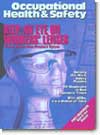
October 2003
Features
By Fred Elliott
IT'S a good idea to monitor OSHA's Standard Interpretations site on a regular basis. You can easily find the site by clicking on the "interpretations" link right from OSHA's www.osha.gov homepage.
By Thomas R. Krause, Ph.D.
SINCE it first rose to popularity in the early 1990s, behavior-based safety (BBS) has become an established and widely respected tool for safety improvement. While not without its critics, BBS has clearly had its successes.
By Casey Hayes
PEOPLE's reaction to being hit with cold water has been used in comedy routines for as long as anyone can remember. Providing it's not you being doused, it can be really funny. But cold water, when used in emergency showers and eyewashes, is no joke.
By Randy DeVaul
HAS your organization hit a plateau in safety? Are you looking for ways to improve the safe performance of your people? Performance Safety provides effective solutions with optimal participation from your employees.
By Lee D. Hager
OSHA's 29 CFR 1904 took effect in January 2003. It make hearing loss is recordable if it meets these criteria
By Greg W. Richey, CIH, CSP
HOW often do we as health and safety professionals ask ourselves, "I wonder if there is a psychosocial component to these indoor air quality complaints?" In fact, environmental health & safety professionals are not qualified to make judgment calls regarding the psychological basis of reported or displayed symptoms among employees.
By Alan Baek
"WHAT is a smoke detector?" Such a question would draw raised eyebrows and possibly snickers in an average gathering of office employees. "What is an AED?" Unless you're in the business, a techie, a safety director, an EMS responder, or a medical professional, you may have no idea the initials AED stand for automated external defibrillator.
By Alan Austin
THROUGHOUT industry, from chemical and petrochemical processing to wastewater utilities and pulp and paper mills, workplaces have the potential to be exposed to toxic gases, combustible gases and vapors, and oxygen deficiency.
By Andrew Beaudoin
IN the open, sandy desert of a foreign country or in the confines of a maintenance work area, Master Sergeant Chad Lingerfelt strives to operate a safe work environment. As a ground safety manager for the U.S. Air Force, Lingerfelt supervises personnel who dismantle, clean, and reassemble aircraft all over the world.
By
DEVELOPING and implementing a comprehensive industrial hygiene strategy can be daunting even under the best circumstances. Ensuring proper characterization, prioritizing actions, performing monitoring, and interpreting the results requires process knowledge, technical skills, sufficient personnel, and of course, money.
By Randy DeVaul
AT 10:18 a.m., the rumble and roar of a Tuesday morning earthquake has just collapsed a 10-story downtown building housing offices for more than 600 people. You jump when the silence is shattered by the dispatcher toning out a report of a missing 4-year-old child, last seen playing in her backyard.
By Bernard R. Blais, M.D., FAAO, FACOEM, FACS, Thomas Tredici, Sr., M.D.
PREVENTION of work-related health complaints should be a top priority for occupational health professionals. Diagnosis and treatment of workers presenting with work-related problems represents an opportunity to prevent recurrences in those workers (tertiary prevention), to mitigate the effects of current work-related hazards in order to reduce the duration of the problem (secondary prevention), and to prevent the same problems in co-workers and those in similar jobs (primary prevention).
By Jerry Laws
PROSPECTS couldn't be brighter for the automated external defibrillator market than they are right now. Liability concerns have receded thanks to "Good Samaritan" laws; new AEDs are lighter, smarter, more capable, and as much as 25 percent cheaper than older models; a battery of important authorities, from OSHA to the General Services Administration, the American College of Occupational and Environmental Medicine, and the Building Owners and Managers Association International, are urging widespread deployment.
By Linda F. Johnson, MS, CSP
SHOWERS of falling ash and cinders blow onto TV crews reporting a fire. The next day, an arson investigator digs in the charred remains of that fire. A crime scene investigator takes blood samples and fingerprints for analysis from a brutal murder, while demolition crews work amid clouds of dust, concrete, and metal particles.
Departments
By Jerry Laws
SOME weekdays I feel darn lucky to reach my office or my home unscathed. I am a good driver, far from a perfect driver, whose urban commute often puts me in close contact with motorists who drive dangerously, competitively, even angrily.
By Valerie Weadock
IF you type the phrase "EHS audit" into any of the Internet's more popular search engines, it just might take you longer to read through and decipher the search results than to actually perform a simple audit. Instead of finding information on the auditing procedure, you'll be linked to the Web sites of hundreds of companies willing to help you with your every EH&S auditing need.
By John C. Donnelly, MS, CSP, IHIT
"DO I have to go to safety training again?" "Is this the same safety training video that we saw last year?" Most safety professionals have had to field these questions at one time or another.